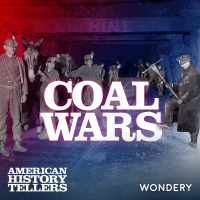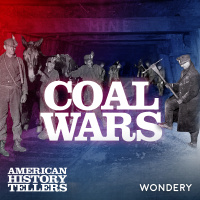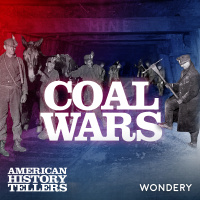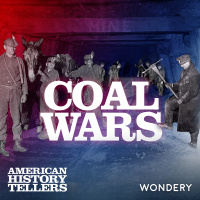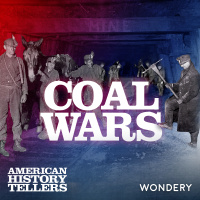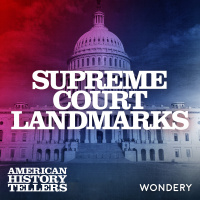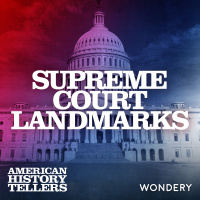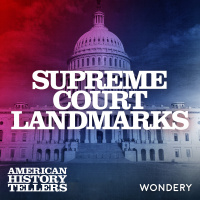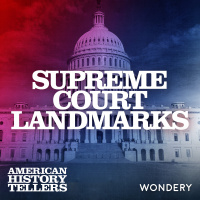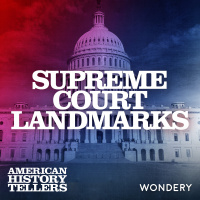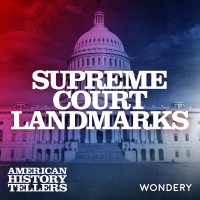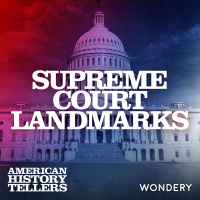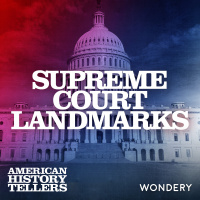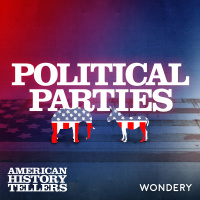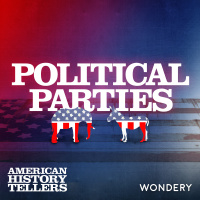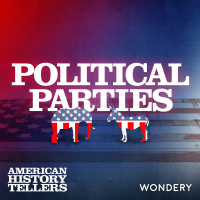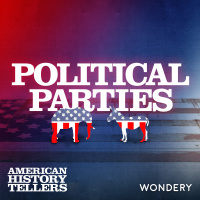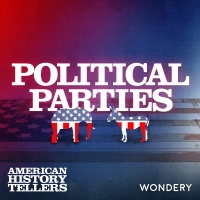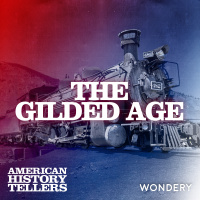Sinopsis
The words you speak. The ideas you share. The freedoms you defend. Every part of your life can be traced to our shared history, but how well do you really know the stories that made America? We’ll take you to the events, the times and the people that shaped our nation and Americans. And we’ll show you how our history affected them, their families and affects you today. Hosted by Lindsay Graham. From Wondery, the network behind Tides Of History, History Unplugged, Fall Of Rome and Dirty John.
Episodios
-
Coal Wars | Charles Keeney on Restoring His Great Grandfather’s Legacy | 5
13/01/2021 Duración: 45minOnce the coal miners lost the Battle of Blair Mountain, the story of their uprising was suppressed, and their leader Frank Keeney eventually faded into obscurity—even among members of his own family. But historian Charles Keeney, Frank Keeney’s great grandson, has made it a personal mission to raise public awareness of the mine wars and the pivotal role his ancestor played. Charles Keeney is the founder of the West Virginia Mine Wars Museum and author of The Road to Blair Mountain: Saving a Mine Wars Battlefield from King Coal. He’s also the vice president of Friends of Blair Mountain, an organization dedicated to the preservation and development of the Blair Mountain Battlefield site. He and Lindsay discuss the circumstances that led to Frank Keeney’s radicalization, his friendship with Mother Jones, and why the miners’ uprising resonates with younger generations today. For more on Charles Keeney: https://twitter.com/cbelmontkeeney Listen to new episodes 1 week early and to all episodes ad fre
-
Coal Wars | The Battle of Blair Mountain | 4
06/01/2021 Duración: 37minThe Coal Wars reached an explosive climax in August 1921, as thousands of miners furious over the death of their hero Sid Hatfield shouldered their weapons and marched south. Their destination was Mingo County, where they hoped to free their fellow miners jailed under martial law.But first, they would have to cross Blair Mountain and armed men led by Logan County’s ruthless anti-union Sheriff Don Chafin. With machine guns and private planes at his disposal, Chafin was prepared to defeat the miners at any cost. Soon, two civilian armies erupted in war, and Blair Mountain became the battleground for the largest armed uprising since the Civil War.Listen to new episodes 1 week early and to all episodes ad free with Wondery+. Join Wondery+ for exclusives, binges, early access, and ad free listening. Available in the Wondery App https://wondery.app.link/historytellers.Support us by supporting our sponsors!See Privacy Policy at https://art19.com/privacy and California Privacy Notice at https://art19.com/privacy#do-n
-
Coal Wars | Bloody Mingo | 3
30/12/2020 Duración: 38minIn May 1920, Sheriff Sid Hatfield won the loyalty of Mingo County’s miners after a deadly gun battle that left seven Baldwin-Felts agents dead on the streets of Matewan, West Virginia. That summer, the coal companies brought in trainloads of strikebreakers to get the mines running again. But local miners were electrified by the Matewan Massacre and they waged an all-out guerilla war as Hatfield awaited trial for murder. For months, gunfire and explosions echoed over the hills of Mingo County as the coal companies and their hired guards fought back with equal force. As “Bloody Mingo” made national headlines, the Governor moved to stop the unrest, imposing martial law. Soon, the military regime ruling Mingo County unleashed new atrocities against the miners and their families. And a shocking assassination sparked calls for revenge.Listen to new episodes 1 week early and to all episodes ad free with Wondery+. Join Wondery+ for exclusives, binges, early access, and ad free listening. Available in the Wondery
-
Coal Wars | The Matewan Massacre | 2
23/12/2020 Duración: 40minIn March 1913, famed labor activist Mother Jones was locked up in a shack in Pratt, West Virginia, suffering from pneumonia and a high fever as she awaited court martial. For a year, the striking miners she led endured hunger and violence as they waged their desperate battle for the right to organize. Now, their struggle hung in the balance. West Virginia was under martial law, and hope for victory over the powerful coal companies seemed dimmer than ever. Newly inaugurated Governor Henry Hatfield vowed to end the crisis. But the deal would drive a wedge through the miners’ movement. New leaders took charge of the union, steering the miners through World War I and a daring new campaign into the state’s isolated southern counties. Soon, a violent showdown in the mountain town of Matewan would ignite a new, dangerous escalation in the conflict. Listen to new episodes 1 week early and to all episodes ad free with Wondery+. Join Wondery+ for exclusives, binges, early access, and ad free listening. Available i
-
Coal Wars | The Most Dangerous Woman in America | 1
16/12/2020 Duración: 39minIn the early 20th century, coal was the fuel that powered the nation. But the men who mined it in the rugged and remote hills of West Virginia endured harsh exploitation by the coal companies that controlled their lives. In the spring of 1912, miners in West Virginia’s Kanawha Valley rose up against the companies and their powerful allies in law enforcement with a strike for their right to join a union.But the mine operators responded with force. They hired private security agents to attack the miners and their families and evict them from their homes. Soon, the escalating conflict brought the era’s most notorious labor activist, Mother Jones, to the scene. A self-described “hellraiser,” Jones joined forces with miners on the ground, sparking a series of bloody armed clashes that would rage across West Virginia for the next decade. Listen to new episodes 1 week early and to all episodes ad free with Wondery+. Join Wondery+ for exclusives, binges, early access, and ad free listening. Available in the Wondery A
-
Supreme Court Landmarks | The Outsize Power of the Supreme Court Today | 8
09/12/2020 Duración: 37minThroughout our series, we've seen how social movements and partisan politics helped influence the decisions of landmark U.S. Supreme Court cases, and thus shape America itself. But how did the Supreme Court get so powerful when America's founders imagined a more limited role? Today, the idea of court-packing, first proposed by Roosevelt to push through his New Deal agenda, is back as a way to rein in the power of the Court. In this episode, Lindsay speaks with Rachel Shelden, an associate professor of history at Penn State and director of the George and Ann Richards Civil War Era Center about how the Court’s power has grown since its founding, and how politicians and presidents could use that to their advantage.For more on Rachel Shelden: https://history.la.psu.edu/directory/ras6620Support us by supporting our sponsors!See Privacy Policy at https://art19.com/privacy and California Privacy Notice at https://art19.com/privacy#do-not-sell-my-info.
-
Supreme Court Landmarks | Jane Roe | 7
02/12/2020 Duración: 41minIn 1970, a 22-year-old woman in Texas named Norma McCorvey tried and failed to get an abortion from her doctor. Abortion was illegal in Texas, just as it was in most states. Women hoping to terminate their pregnancies had few options, and many resorted to risky back-alley procedures.McCorvey was soon introduced to a pair of young lawyers who hoped to go to court to challenge the Texas law banning abortion. Before long, McCorvey became the plaintiff known only as “Jane Roe.”Her case eventually made its way to the Supreme Court, where the Justices would rule on whether the constitutional right to privacy applied to abortion. The Court’s landmark ruling changed the lives of American women, and unleashed intense controversy, dividing the nation for decades to come.Listen ad free with Wondery+. Join Wondery+ for exclusives, binges, early access, and ad free listening. Available in the Wondery App https://wondery.app.link/historytellers.Support us by supporting our sponsors!See Privacy Policy at https://art19.com/p
-
Supreme Court Landmarks | A Recount in Florida | 6
25/11/2020 Duración: 41minThe morning of Nov. 8, 2000, Americans woke up to an undecided election. Pollsters had predicted a close race between Vice President Al Gore and Texas Governor George W. Bush, but no one knew just how narrow the margins would be. It all hinged on Florida, where 25 electoral votes were up for grabs.Over the next 36 days, armies of lawyers waged a bitter fight to determine how to count the votes in Florida. It was a battle that would eventually find its way to the Supreme Court.In its long history, the Court had been asked to weigh in on political matters, but never before had it intervened in the results of a presidential election. The case that became known as Bush v. Gore would ultimately send one man to the White House and expose the Court to intense public scrutiny.Listen ad free with Wondery+. Join Wondery+ for exclusives, binges, early access, and ad free listening. Available in the Wondery App. https://wondery.app.link/historytellersSupport us by supporting our sponsors!See Privacy Policy at https://art
-
Supreme Court Landmarks | The Warren Court | 5
18/11/2020 Duración: 40minBefore the 1950s, the Supreme Court was best known as an institution that adhered to the status quo. It often sought to protect the rights of property owners and businessmen, shying away from cases that took direct aim at controversial social or political issues.But when a popular former California governor became Chief Justice in 1953, all that changed. Earl Warren’s court would take on some of the hottest issues of the times, ruling on cases where individual rights would take precedent, such as Brown v. Board of Education and Baker v. Carr, and where First Amendment and Fifth Amendment rights would be strengthened, such as Engle v. Vitale and Miranda v. Arizona. For sixteen years, the Warren Court would radically reshape the legal and social landscape of America.Listen ad free with Wondery+. Join Wondery+ for exclusives, binges, early access, and ad free listening. Available in the Wondery App. https://wondery.app.link/historytellersSupport us by supporting our sponsors!See Privacy Policy at https://ar
-
Supreme Court Landmarks | Loaded Weapon | 4
11/11/2020 Duración: 40minThrough most of 1941, as fighting raged across Europe, the United States held back from entering the war. That all changed in December, when Japanese fighter planes bombed Pearl Harbor and the nation found itself mobilizing for World War II. Suddenly, the frenzy to fight enemies abroad turned to suspicion against those at home.President Roosevelt signed Executive Order 9066, giving the military the power to detain and permanently jail over 110,000 Japanese Americans living on the West Coast. But three young detainees would defy their fate.Fred Korematsu, Gordon Hirabayshi and Mitsuye Endo would challenge the U.S. policy of Japanese internment and bring their cases all the way to the Supreme Court — pitting the wartime powers of the United States against the constitutional rights of American citizens.Listen ad free with Wondery+. Join Wondery+ for exclusives, binges, early access, and ad free listening. Available in the Wondery App. https://wondery.app.link/historytellersSupport us by supporting our sponsors!S
-
Supreme Court Landmarks | Separate and Unequal | 3
04/11/2020 Duración: 35minAfter the Civil War, America began to rebuild a shattered nation. For the first time, the country could create a society without slavery, and a nation where Black people could forge their own path as independent citizens.But by the 1890s, the laws and policies that promised new rights for Black citizens in the South were under assault. In Louisiana, white politicians attempted to turn back the clock on racial progress by passing the Separate Cars Act and reinstating segregation. The move prompted a Black New Orleans activist group called the Comité des Citoyens to rise up and challenge the law. Members Louis Martinet and Albion Tourgee aimed to build a test case – a case that would force the Supreme Court to strike down segregation laws, and disprove the idea that “separate” could ever be “equal.” The high-stakes case would define race relations for decades to come. And it would begin with a brief train car ride in New Orleans, by a 29-year-old shoemaker named Homer Plessy.Listen ad free with Wonder
-
Supreme Court Landmarks | The Cherokee Cases | 2
28/10/2020 Duración: 40minIn the early 1800s, the United States was growing rapidly, seeking land and resources for its expanding population. But the growth threatened Native American communities throughout the East. In the southern Appalachia region, the Cherokee Nation held millions of acres of prime farmland and forests, managed by a centuries-old tradition and a thriving government. But the state of Georgia, and a relentless President Andrew Jackson, set their sights on seizing the land. When the Georgia statehouse declared political war, Cherokee advocates fought back. Newspaper publisher Elias Boudinot and Cherokee Chief John Ross took their challenge all the way to the Supreme Court, forcing Chief Justice John Marshall to weigh in on two monumental cases, Cherokee Nation v. Georgia and Worcester v. Georgia. At stake was a decision that would test the limits of the high court’s power -- and determine the future and sovereignty of a threatened nation. Listen to new episodes 1 week early and to all episodes ad free
-
Supreme Court Landmarks | The Predicament of John Marshall | 1
21/10/2020 Duración: 35minAfter the War of Independence, the new American government created the Supreme Court to be have the final word on disputes that the states couldn’t settle. But at first, the Court was anything but Supreme.For nearly a decade, Congress and the President held the real power. In practice the Supreme Court was weak, ineffectual and disorganized – a post so unappealing that many men turned down nominations to serve on its bench. All that would change with the appointment of Chief Justice John Marshall and the arrival of a case called Marbury v. Madison — a political drama that would embroil the new President Thomas Jefferson, outgoing president John Adams, the U.S. Congress, and even the Chief Justice himself.Listen to new episodes 1 week early and to all episodes ad free with Wondery+. Join Wondery+ for exclusives, binges, early access, and ad free listening. Available in the Wondery App. hereSupport us by supporting our sponsors!See Privacy Policy at https://art19.com/privacy and California Privacy Notice a
-
Encore: Political Parties | The Reagan Revolution | 6
14/10/2020 Duración: 49minThe year 1968 marked a watershed in American politics. Anti-war protests were roiling the country. Civil rights leader Martin Luther King Jr. was shot dead in Memphis. Democratic President Lyndon Johnson’s approval rating was plummeting. The assassination of Democratic presidential hopeful Robert Kennedy would throw the party into disarray, toppling the New Deal coalition built by Franklin Delano Roosevelt two generations earlier and leading to a conservative surge.The political sea change would drive Republican nominee Richard Nixon to the White House in 1968. And it would eventually elect a former actor and California governor who would change the face of American politics in ways that are still being felt to this day. His name was Ronald Reagan.Listen ad-free on Wondery+ hereSupport us by supporting our sponsors!See Privacy Policy at https://art19.com/privacy and California Privacy Notice at https://art19.com/privacy#do-not-sell-my-info.
-
Encore: Political Parties | The New Deal Coalition | 5
07/10/2020 Duración: 45minThe 1929 stock market crash saw 14 billion dollars vanish in a matter of hours — and with it, the Republican party’s decades-long grip on American politics. As Americans lost their livelihoods, they turned to President Herbert Hoover for relief. But the self-made man who had so successfully reversed his own fortunes seemed unable to do the same for his country. With discontent growing, Hoover turned on World War veterans demanding early bonus payouts to support their families. It would prove the last straw for many Americans.The landslide election of 1932 would mark a profound realignment in U.S. politics, bringing urban centers under Democratic control for the first time in the party’s history. And it would propel into the White House Franklin Delano Roosevelt, whose sweeping New Deal would permanently transform the American political landscape.Support this show by supporting our sponsors!See Privacy Policy at https://art19.com/privacy and California Privacy Notice at https://art19.com/privacy#do-not-sell-my
-
Encore: Political Parties | The Golden Age of the GOP | 4
30/09/2020 Duración: 47minAs the Civil War came to a close, the government set its sights once again on the future of the United States. Working closely with a Republican President, the Republican Congress expected a swift and peaceful road to Reconstruction. But then, a mere four weeks into his second term, Lincoln was assassinated, leaving the country in the hands of Andrew Johnson, a Southern Democrat who had personally owned slaves just three years before.While Johnson’s unwavering commitment to states rights cultivated a fraught relationship with his Congress, the tumult would ultimately be short-lived. After just four years of a Democratic president, America’s Grand Old Party would ascend to power—and hold it—for over 70 years.Listen ad-free on Wondery+ hereSupport us by supporting our sponsors!See Privacy Policy at https://art19.com/privacy and California Privacy Notice at https://art19.com/privacy#do-not-sell-my-info.
-
Encore: Political Parties | The Turbulent 1850s | 3
23/09/2020 Duración: 43minThe United States won the The Mexican–American War in the 1840s, and with it vast new stretches of western land. But in the 1850s, the question of what to do with this land – and whether to allow slavery in the new territories or not – became a redning issue for politicians of all stripes.While the Whig Party collapsed over the issue, Democrats split into Northern and Southern factions, and a new Republican Party tried to bind the Union with an appeal to old Jeffersonian values. But in the houses of Congress and across the nation, negotiations fail, compromise is abandoned; and the issue of slavery will overshadow all else, leading to Civil War.Support us by supporting our sponsors!See Privacy Policy at https://art19.com/privacy and California Privacy Notice at https://art19.com/privacy#do-not-sell-my-info.
-
Encore: Political Parties | Jacksonian Democracy | 2
16/09/2020 Duración: 47minAndrew Jackson lost the 1824 presidential election to John Quincy Adams through what some called a “corrupt bargain” in the House of Representatives. The maneuver was masterminded by hot-headed but politically savvy Henry Clay, who with Adams, announced their intent for far-reaching new federal programs. Fierce opposition to these policies united pro-Jackson supporters who formed a new party, the Democrats, to rally around their hero and elect him to president in 1828.But while Adams was defeated, Henry Clay had no intention of leaving the fight. He helped lead a new party which gathered together anti-Jackson, fiscal conservatives, and pro-states rights factions. The rise of Clay’s new Whig party seemed unstoppable–they captured both houses of Congress and the presidency–until, on April 4, 1841, president William Henry Harrison died in office and gave John Tyler the power of the veto.Support this show by supporting our sponsors!See Privacy Policy at https://art19.com/privacy and California Privacy Notice at h
-
Encore: Political Parties | A Tale of Two Parties | 1
09/09/2020 Duración: 45minIn the earliest days of the United States, there was no such thing as an organized political party. George Washington, elected twice to the presidency unanimously in the Electoral College, warned the new nation against political factions, writing that organized parties would become, “potent engines, by which cunning, ambitious, and unprincipled men subvert the power of the people.”But immediately after Washington vacated the Presidency, factions did spring up and bitter personal rivalries began to shape the nation. The two first political parties–the Federalists and the Republicans–had very different views of what America should become, and were led by very different men: Alexander Hamilton and Thomas Jefferson.Listen ad free with Wondery+. Join Wondery+ for exclusives, binges, early access, and ad free listening. Available in the Wondery App. https://wondery.app.link/historytellersSupport us by supporting our sponsors!See Privacy Policy at https://art19.com/privacy and California Privacy Notice at https://ar
-
The Gilded Age | What America Failed to Learn from the Gilded Age | 7
02/09/2020 Duración: 38minThroughout our series, corporate giants and their exploitation of workers was disturbing evidence of capitalism run amok. That greed and disregard for the working class defined the Gilded Age. But the problems of that era haven’t disappeared. The economic disparities that were forged in the Gilded Age are still affecting our country. And monolithic companies like Facebook and Apple continue to grow, leaving a burning question of whether big tech has too much power. Today, Lindsay speaks with Tim Wu, a Columbia law professor and author of “The Curse of Bigness: Antitrust in the New Gilded Age,” about the economic and social changes that took place then, and how they set the stage for modern America. For more on Tim Wu: http://www.timwu.org/about.htmlListen ad-free on Wondery+ hereSupport us by supporting our sponsors!See Privacy Policy at https://art19.com/privacy and California Privacy Notice at https://art19.com/privacy#do-not-sell-my-info.

